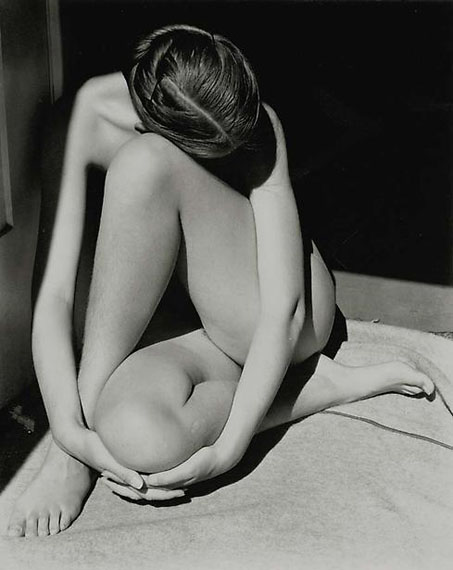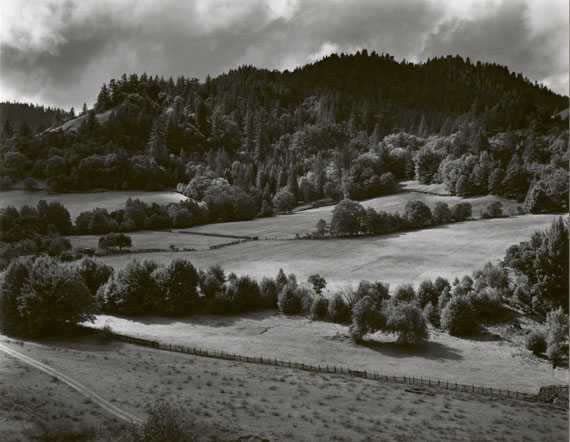
Edward Weston »
EDWARD WESTON
Exhibition: 7 Nov 2013 – 11 Jan 2014

EDWARD WESTON
7 November 2013 – 11 January 2014
Galerie Edwynn Houk will present for the first time in our Zurich gallery a selection of prints by the American photographer, Edward Weston (1886-1958). Weston has long been considered one of the Modernist Masters of the medium, and certainly one of the most important and highly regarded photographers from the United States.
From the soft focus, more pictoralist style synonymous with his predecessors, Alfred Stieglitz and Edward Steichen, the oeuvre of Edward Weston marks the medium’s shift to the straight photograph, of images rendered in crisp detail and sharp focus. His subject matter was varied and far reaching: nudes, multiple landscapes, portraits, still lifes, as illustrated by the prints on view. Included are early nudes, exquisitely composed, of Tina Modotti and Margrethe Mather, and multifarious and indefatigable studies of everyday, commonplace objects like Excusado, 1925, and Kale Halved, 1930. Also exhibited are some of the most famous and mature nudes he took of his second wife Charis in the mid 1930s, and later landscapes, like Tomales Bay, 1937, and Eel River Ranch, 1937, that Weston took when he had secured the funding of a coveted Guggenheim Fellowship in 1937. He was the first ever photographer to do so. But it is perhaps in some of his most famous nudes, like Charis in the Doorway, 1936, or in the rich depiction of shells and vegetables, like Pepper, 1929, that one can decipher Weston’s impeccable technique and his remarkable sensitivity. Weston, in all of his photographs, relentlessly explored the dichotomy between subject and form, realism and abstraction. His career was a search for the essence of the thing itself, whether of a nude, or of a vegetable, or within a landscape.
Throughout his entire career, Weston paid acute attention to how the subject matter appeared in his viewfinder. He had to see the final picture on the glass plate in the camera before making the exposure, feeling that the “print is a duplication of all that I saw and felt through my camera.” Weston made copious notes and wrote particular instructions for how each image should be printed. These prints on view have been printed by his youngest son Cole Weston (1919-2003). Cole, a photographer in his own right, began printing his father’s pictures in the late 1940s under Edward’s close supervision, and after his death, Cole continued to print from his father’s negatives for the next twenty years. As stipulated by Edward Weston’s will, no further posthumous prints have been made.
Edward Weston was born in Chicago, and moved to California in 1921, where he opened his first studio. He had his first solo exhibition in New York at the Delphic Studios in 1930. In 1932, he was one of the co-founders, with Ansel Adams, of Group f.64. He was the subject of his first major retrospective at the Museum of Modern Art, New York, in 1946, with an accompanying monograph published to mark the occasion. His work has been the subject of numerous exhibitions and publications following his death from Parkinson’s Disease in 1958. �

EDWARD WESTON
7. November 2013 – 11. Januar 2014
Die Galerie Edwynn Houk wird erstmalig in unseren Zürcher Räumen eine Auswahl von Abzügen des amerikanischen Fotografen Edward Weston (1886-1958) präsentieren. Weston gilt seit langem als einer der führenden Modernisten des Mediums und in jedem Fall als einer der bedeutendsten und renommiertesten Fotografen der Vereinigten Staaten.
Ausgehend vom weich gezeichneten, eher piktorialistischen Stil eines Alfred Stieglitz und Edward Steichen, markierte das Œuvre Edward Westons die Hinwendung des Mediums zur reinen Fotografie, oder straight photography, zu Bildern mit hoher Detail- und Bildschärfe. Wie in der Auswahl der ausgestellten Arbeiten zu sehen, waren seine Themen dabei abwechslungsreich und tief greifend: Akte, verschiedene Landschaften, Porträts, Stillleben. Gezeigt werden sowohl frühe, ausgesprochen exquisit komponierte Aktfotografien von Tina Modotti und Margrethe Mather als auch facettenreiche und unermüdliche Alltagsstudien, gewöhnliche Objekte, wie Excusado, 1925, und Kale Halved, 1930. Des Weiteren beinhaltet die Ausstellung einige der bekanntesten und reifsten Aktaufnahmen, die Weston von seiner zweiten Frau Charis in den mittleren 1930er Jahren machte, wie Tomales Bay, 1937 und Eel River Ranch, 1937. Letztere produzierte er, nachdem er sich 1937, als erster Fotograf überhaupt, eine finanzielle Unterstützung über das begehrte Guggenheim Fellowship sichern konnte. Es ist vielleicht in einigen dieser berühmten Aktfotografien, wie Charis in the Doorway, 1936, oder den opulenten Abbildungen von Muscheln und Gemüse, wie Pepper, 1929, in denen man Westons makellose Technik und seine außergewöhnliche Sensibilität erkennen kann. In all seinen Fotografien erkundete Weston unablässig den Zwiespalt zwischen Sujet und Form, Realismus und Abstraktion. Seine fotografische Entwicklung war dabei die Suche nach dem Wesen der Dinge, ob nun im Akt, oder in einer Feldfrucht, oder in der Landschaft.
Während der gesamten Zeit seines fotografischen Schaffens legte Weston großen Wert darauf, wie sein Sujet schon durch den Bildsucher erscheint. Da für ihn „der Abzug ein Duplikat all dessen ist, was ich durch die Kamera sah und fühlte“, war es für ihn zwingend, das vollendete Bild schon vor der Belichtung wie gewünscht auf der Sucherscheibe zu sehen. Weston machte dabei ausgiebige Notizen und schrieb akribische Instruktionen, wie das jeweilige Foto abgezogen werden sollte. Die hier ausgestellten Abzüge wurden von seinem jüngsten Sohn Cole Weston (1919-2003) produziert. Cole, selbst auch Fotograf, begann in den späten 1940er Jahren, die Bilder seines Vaters abzuziehen, immer unter der direkten Anleitung Edwards. Cole hat dann nach dem Tod seines Vaters noch weitere 20 Jahre dessen Negative abgezogen. Darüber hinaus jedoch, wie im Testament Edward Westons entsprechend verfügt, wurden und werden keine weiteren posthumen Abzüge hergestellt.
Edward Weston wurde in Chicago geboren und zog 1921 nach Kalifornien, wo er sein erstes Fotostudio eröffnete. Seine erste Einzelausstellung fand 1930 in den Delphic Studios in New York statt. Zusammen mit Ansel Adams war er 1932 einer der Mitbegründer der Group f.64. 1946 widmete ihm das Museum of Modern Art in New York eine erste umfassende Retrospektive, begleitet von einem monografischen Bildband. Seit seinem Tod durch Parkinson-Krankheit 1958 waren seine Fotografien Gegenstand unzähliger Ausstellungen und Publikationen.�


